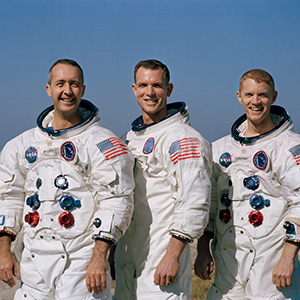
| Project Home | About the Scans | Browse Gallery | Image Map | Support Data | Resources | Ephemeris |
 For a complete listing of featured images: Featured Image List |
In 1961, President John F. Kennedy announced an ambitious goal of sending an American safely to the Moon before the end of the decade. First, NASA learned to live and work in space with the Mercury and Gemini missions. Ultimately, NASA answered the challenge in 1969 with the successful landing of the Apollo 11 Lunar Module (LM). To record their historic voyages and collect scientific observations many thousands of photographs were acquired with handheld and automated cameras during all the Apollo missions. After returning to Earth, the film was developed and stored at Johnson Space Center (JSC), where they still reside. Due to the historical significance of the original flight films, typically only duplicate (2nd or 3rd generation) film products are currently available for study and used to make prints.
To allow full access to the original flight films for both
researchers and the general public, Johnson Space Center and Arizona
State University's Space Exploration
Resources are scanning and creating an online digital archive of
all the original Apollo flight films. Through this online interface,
users may browse through the archive and download any of the images.
This web site also provides a suite of resources regarding the images
and the cameras that were used during the Apollo program. Finally, be sure
to check out the amazing collection of images from the successful
Lunar Reconnaissance Orbiter Camera
and the March to the Moon archive
of handheld images from Mercury, Gemini, and Apollo.

Current Project Status
Metric and Panoramic Frame scanning and processing has been completed! The full collection consists of 10,153 Metric frames and 4,697 Pan frames. There are also handheld images available from the Mercury, Gemini, and earlier Apollo missions in the Browse Gallery!
|
|
Space Exploration Resources |
|
 LPI LPI
|